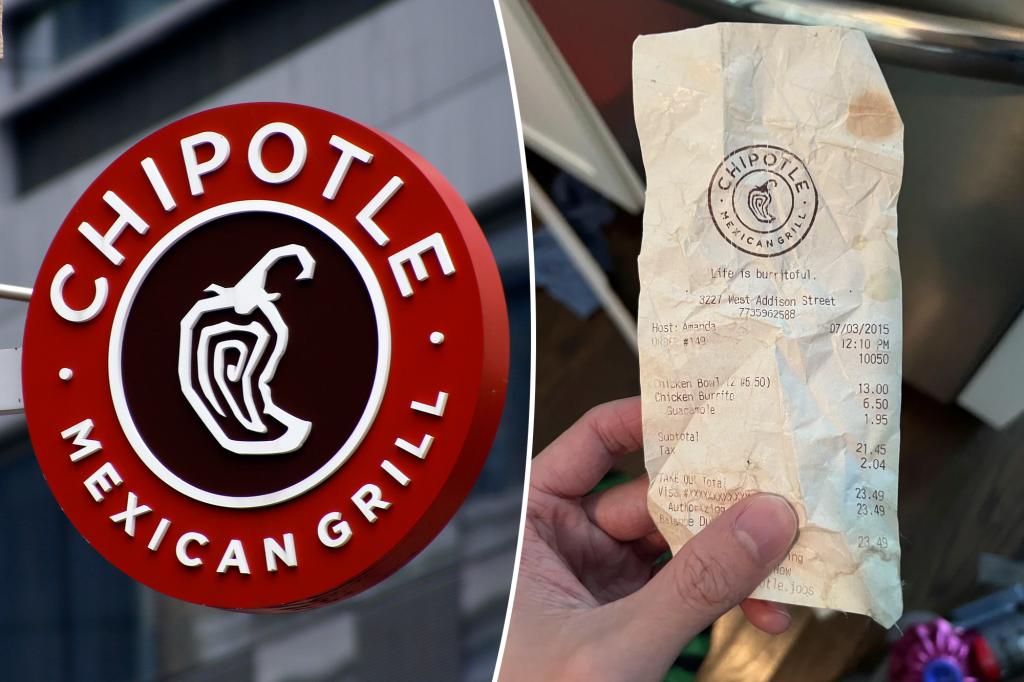The Rising Cost of Burritos: A Decade of Inflation at Chipotle
Fast food, once a symbol of affordable convenience, has increasingly become a source of frustration for consumers grappling with inflation. A recent viral Reddit post has ignited a fiery debate about the rising cost of eating out, specifically at popular chains like Chipotle. The post, featuring a ten-year-old receipt, highlights the stark contrast between prices in 2015 and today, leaving many questioning the true impact of inflation on their wallets.
A Blast from the Past: The 2015 Chipotle Receipt
The Reddit user, a Chicago resident, stumbled upon a forgotten relic from under their dishwasher: a Chipotle receipt dated July 2015. The receipt detailed a purchase of two chicken bowls and one chicken burrito, all accompanied by guacamole. The total cost, before tax, was a mere $21.45. The itemized breakdown revealed the individual prices: $6.50 for each bowl and burrito, and $1.95 for the guacamole.
This seemingly insignificant piece of paper triggered a wave of nostalgia and, more importantly, outrage. Fellow Redditors, quick to quantify the effects of inflation, meticulously compared the 2015 prices to current costs at the same Chipotle location.
The 2025 Reality: A 43.58% Price Increase
The comparison revealed a significant increase in prices. Today, a chicken bowl and a chicken burrito at the same Chicago Chipotle location cost $9.35 each. The guacamole, once a steal at $1.95, now demands $2.75. This means that the exact same order that cost $21.45 in 2015 now totals $30.80 before tax – a staggering 43.58% increase over the decade.
Is Chipotle’s Inflation “About CPI”?
The original poster suggested that the price increase was “about CPI,” referring to the Consumer Price Index. The CPI is a key economic indicator that measures the average change over time in the prices paid by urban consumers for a basket of consumer goods and services. It’s often used as a benchmark to understand inflation rates and adjust wages or payments accordingly.
While the 43.58% increase in Chipotle’s prices is significant, it’s important to consider whether it directly mirrors the overall CPI during that period. Inflation rates can fluctuate, and specific industries or companies may experience price changes that deviate from the national average. Factors such as supply chain issues, labor costs, and company-specific pricing strategies can all contribute to price variations.
Consumer Reaction: Anger, Nostalgia, and a Call for Simpler Times
The revelation of Chipotle’s price increase sparked a range of emotions among Reddit users. Many expressed anger and frustration at the rising cost of living, lamenting the days when a fast-food meal wouldn’t break the bank.
“$11 difference is crazy,” one user commented. “Ugh take me back to 2015.”
Another exclaimed, “2 bowls and a burrito for THAT price!? Where has the time gone haha. Have I been so conditioned to accept this inflation that I can’t even remember how cheap stuff was just 10 years ago!!??!!”
The comments reflected a shared sense of nostalgia for a time when affordability was less of a concern. Many expressed a longing for the days when a quick and satisfying meal didn’t require a significant financial commitment.
“I miss when it didn’t cost $20 per person for a meal,” one user wistfully noted.
The Broader Picture: Fast Food Inflation Across the US
While the Chipotle receipt provides a specific example of price increases, it’s important to recognize that fast-food inflation is a widespread phenomenon across the United States. Numerous factors have contributed to this trend, including rising labor costs, supply chain disruptions, and increased ingredient prices.
- Labor Costs: Many fast-food chains have faced pressure to raise wages to attract and retain employees, particularly in a tight labor market. These increased labor costs are often passed on to consumers in the form of higher prices.
- Supply Chain Disruptions: The COVID-19 pandemic and other global events have disrupted supply chains, leading to shortages of key ingredients and increased transportation costs.
- Ingredient Prices: The cost of agricultural commodities like beef, chicken, and vegetables has fluctuated significantly in recent years, impacting the overall cost of producing fast-food meals.
These factors have collectively contributed to a noticeable increase in the price of fast food, making it less accessible to budget-conscious consumers.
Fast Food Spending by State: A WalletHub Analysis
A recent study by WalletHub shed light on the regional disparities in fast-food spending across the United States. The study analyzed the percentage of income that residents of different states spend on fast-food purchases.
The analysis revealed that residents of Mississippi spend the highest percentage of their income on fast food compared to any other state in the country. This suggests that fast food may be a more significant part of the diet for people in Mississippi, or that they may have less disposable income overall.
The Shifting Landscape of Fast Food Value
The rising cost of fast food has implications for the industry as a whole. Consumers are increasingly questioning the value proposition of fast food, particularly as prices continue to climb. They may be more likely to explore alternative options, such as cooking at home or opting for healthier, more affordable meals.
Fast-food chains are responding to these challenges in various ways. Some are focusing on menu innovation, introducing new and exciting items to attract customers. Others are emphasizing value deals and loyalty programs to retain their existing customer base. Still others are focusing on automation and technology to reduce labor costs and improve efficiency.
Chipotle’s Response to Inflation and Consumer Concerns
Chipotle, like other fast-food chains, has faced criticism for its rising prices. The company has defended its pricing strategy by citing factors such as increased labor costs, rising ingredient prices, and investments in food safety and technology.
Chipotle has also implemented various strategies to address consumer concerns about affordability. These include offering value-oriented menu items, promoting its rewards program, and providing options for customization to allow customers to control the cost of their meals.
The Future of Fast Food Affordability
The future of fast food affordability remains uncertain. While inflation is expected to moderate in the coming years, many of the factors that have driven up prices, such as labor costs and supply chain vulnerabilities, are likely to persist.
Fast-food chains will need to continue to innovate and adapt to meet the changing needs and expectations of consumers. This may involve finding ways to reduce costs, improve efficiency, and offer more value for money. It may also require a fundamental shift in the perception of fast food, moving away from the image of cheap and convenient and towards a model that emphasizes quality, sustainability, and affordability.
A Thoughtful Analysis: Beyond the Price Tag
While the viral Chipotle receipt undeniably highlights the impact of inflation on consumer spending, it also invites a deeper analysis of the value we place on convenience, food quality, and ethical sourcing.
- The Convenience Factor: Fast food offers undeniable convenience, particularly for busy individuals and families. However, the rising cost may force consumers to reconsider whether the convenience is worth the price.
- Food Quality and Sourcing: Chipotle, in particular, has positioned itself as a brand that prioritizes fresh ingredients and ethical sourcing. These commitments often come at a higher cost, which is reflected in the menu prices. Consumers must weigh the importance of these factors against their budget constraints.
- The True Cost of Cheap Food: The pursuit of ultra-cheap food can have unintended consequences, such as environmental degradation, exploitation of labor, and compromised nutritional value. Consumers are increasingly aware of these issues and may be willing to pay more for food that is produced in a sustainable and ethical manner.
Ultimately, the debate over Chipotle’s prices is a microcosm of a larger conversation about the future of food affordability, the value we place on convenience and quality, and the ethical considerations that shape our food choices.
Conclusion: A Call for Informed Consumerism
The viral Chipotle receipt serves as a powerful reminder of the impact of inflation on our everyday lives. As consumers, it’s crucial to be informed about the factors that drive price changes and to make conscious choices that align with our values and budget constraints. By demanding transparency, supporting ethical sourcing, and embracing sustainable consumption practices, we can collectively shape a future where affordable and nutritious food is accessible to all.





